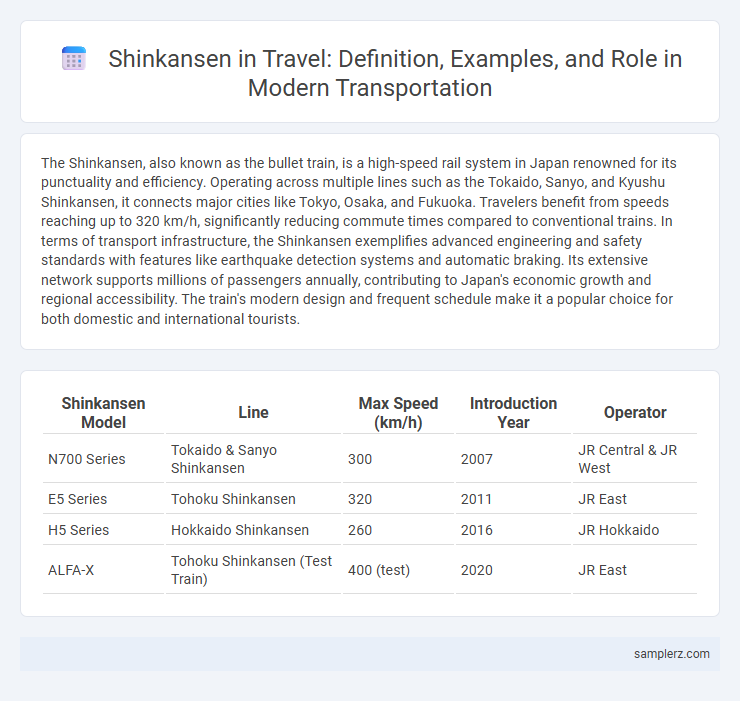The Shinkansen, also known as the bullet train, is a high-speed rail system in Japan renowned for its punctuality and efficiency. Operating across multiple lines such as the Tokaido, Sanyo, and Kyushu Shinkansen, it connects major cities like Tokyo, Osaka, and Fukuoka. Travelers benefit from speeds reaching up to 320 km/h, significantly reducing commute times compared to conventional trains. In terms of transport infrastructure, the Shinkansen exemplifies advanced engineering and safety standards with features like earthquake detection systems and automatic braking. Its extensive network supports millions of passengers annually, contributing to Japan's economic growth and regional accessibility. The train's modern design and frequent schedule make it a popular choice for both domestic and international tourists.
Table of Comparison
| Shinkansen Model | Line | Max Speed (km/h) | Introduction Year | Operator |
|---|---|---|---|---|
| N700 Series | Tokaido & Sanyo Shinkansen | 300 | 2007 | JR Central & JR West |
| E5 Series | Tohoku Shinkansen | 320 | 2011 | JR East |
| H5 Series | Hokkaido Shinkansen | 260 | 2016 | JR Hokkaido |
| ALFA-X | Tohoku Shinkansen (Test Train) | 400 (test) | 2020 | JR East |
Introduction to Shinkansen: Japan’s High-Speed Rail
Japan's Shinkansen exemplifies cutting-edge high-speed rail transport, connecting major cities with speeds exceeding 320 km/h (200 mph). Introduced in 1964, the Shinkansen revolutionized travel by drastically reducing journey times and enhancing safety through advanced bullet train technology. Its extensive network spans over 3,000 kilometers, showcasing Japan's commitment to efficient, reliable, and eco-friendly transportation infrastructure.
Evolution of Shinkansen in Modern Transport
The Shinkansen, often referred to as the bullet train, revolutionized high-speed rail travel in Japan by introducing speeds exceeding 320 km/h, drastically reducing travel time between major cities. Continuous innovations such as aerodynamic train designs, advanced safety systems with earthquake detection, and energy-efficient technology have propelled the Shinkansen to the forefront of modern transport. Its evolution exemplifies the integration of cutting-edge engineering with sustainable passenger mobility, influencing high-speed rail networks worldwide.
Key Shinkansen Lines and Their Routes
The Tokaido Shinkansen connects Tokyo, Nagoya, and Osaka, serving as the busiest high-speed rail line in Japan. The Sanyo Shinkansen extends from Osaka to Fukuoka, linking major western cities. The Tohoku Shinkansen runs from Tokyo to Aomori, covering a vast northern region with efficient high-speed service.
Technological Innovations in Shinkansen Trains
Shinkansen trains utilize cutting-edge aerodynamic designs and advanced regenerative braking systems to enhance energy efficiency and reduce travel time. The incorporation of earthquake detection technology ensures passenger safety by automatically halting trains during seismic activity. High-speed rail innovations such as magnetic levitation and improved onboard communication systems exemplify Japan's commitment to revolutionizing fast, reliable transportation.
Shinkansen vs. Conventional Rail Transport
The Shinkansen, Japan's high-speed rail system, operates at speeds up to 320 km/h, significantly reducing travel time compared to conventional rail transport, which averages 80-130 km/h. Its advanced aerodynamic design and dedicated tracks minimize delays and enhance safety, contrasting with conventional rails that often share tracks with freight trains. The Shinkansen's superior efficiency and punctuality revolutionize intercity travel, offering a reliable alternative to air and road transport.
Environmental Impact of Shinkansen Operations
Shinkansen trains generate significantly lower carbon emissions per passenger kilometer compared to conventional air travel and automobiles, making them an eco-friendly transportation option. Their electric-powered operations reduce reliance on fossil fuels, thereby minimizing air pollution and noise levels along travel corridors. Efficient energy use and regenerative braking systems further enhance the sustainability of Shinkansen services across Japan.
Passenger Experience on Shinkansen Journeys
Passengers on Shinkansen journeys enjoy spacious seating, punctual departures, and smooth acceleration that minimizes motion discomfort. High-speed trains feature advanced suspension systems and noise reduction technologies, enhancing comfort throughout the trip. Onboard amenities such as clean restrooms, vending machines, and Wi-Fi access contribute to a seamless and enjoyable travel experience.
Economic Benefits of the Shinkansen Network
The Shinkansen network significantly boosts Japan's economy by reducing travel time and enhancing productivity, facilitating seamless business operations across major cities like Tokyo, Osaka, and Nagoya. The high-speed rail system stimulates regional economic development by increasing tourism and local investments, generating billions of yen annually in revenue. Its efficient and punctual service also lowers transportation costs and carbon emissions, contributing to sustainable economic growth and improved competitiveness.
Shinkansen's Influence on Global Rail Systems
The Shinkansen system revolutionized high-speed rail technology by introducing pioneering advancements in safety, punctuality, and speed, influencing railway networks worldwide. Countries such as France with the TGV, China with its extensive CRH network, and Spain with the AVE have adopted and adapted features from the Shinkansen to enhance their own high-speed rail services. This innovation not only improved passenger travel efficiency but also set new standards for global rail transport standards and infrastructure development.
Future Developments in Shinkansen Technology
The future developments in Shinkansen technology will focus on increasing maximum speeds to over 360 km/h using magnetic levitation (Maglev) systems, reducing travel time between major cities like Tokyo and Osaka to under an hour. Innovations in energy efficiency include the use of superconducting magnets and regenerative braking systems, minimizing environmental impact and operational costs. Advanced safety features such as automated train control and earthquake detection systems aim to enhance passenger security and operational reliability across Japan's high-speed rail network.

example of shinkansen in transport Infographic
 samplerz.com
samplerz.com